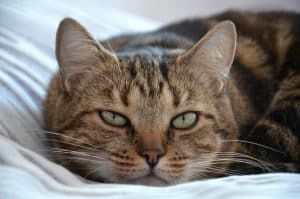
We haven’t discussed pet obesity in a while, with such hot topics as advertising to kids and the GLP-1 weight-loss drugs taking over for a while. So now is a good time as any to revisit this topic.
Although there isn’t currently much in the news about pet obesity, except for some pet food companies tooting their own horn by promoting their weight-management pet food products, maybe the lack of news is still news — or non-news — or at least a stark reminder that not much is being done about our fat pets.
Dogs and cats are getting fatter
A pet obesity survey conducted by the Association for Pet Obesity Prevention in 2022 (the most recent statistics available) showed an increase in overweight and obese dogs and cats, with 59% of dogs and 61% of cats classified as overweight or obese. For dogs, this percentage increased from 56% in 2018 and 2017, and for cats a slight increase from 60%.
Let’s put this in perspective. To put a visual on how even a “little” weight gain for a pet compares to an average human, for a cat, 2 lbs over ideal weight is equivalent to 30 lbs in humans. For a small dog, compared to a human, it’s 12 lbs, and for a large dog, it’s 5 lbs.
Other key survey findings include these revelations:
Consistent with previous surveys, many dog and cat owners failed to recognize excess weight or overweight body conditions in their pets. Nearly one-third (32%) of owners of overweight or obese pets (BCS 6-9) classified their pet as “normal,” “ideal,” or “thin” body condition when asked by their veterinary professional.
36% of dog owners considered their pet’s body condition “normal” when their veterinary professional classified it as BCS 6-9 (overweight to obesity).
28% of cat owners considered their pet’s body condition “normal” when their veterinary professional classified it as BCS 6-9 (overweight to obesity).
That’s a pretty skewed perception, especially considering the fact that pets count on us to keep them healthy.
Do veterinarians discuss healthy weight?
Yes, and it’s gotten better. The survey found that 49% of respondents reported that their veterinary professionals discussed their pet’s ideal or healthy weight yearly, compared to 46% in 2021. Adding to this somewhat hope-inspiring finding, two-thirds (67%) of pet owners surveyed said they “have not felt embarrassment or uncomfortable after being told their pet needed to lose weight.”
Pet weight loss strategies and success rates
The numbers show that the majority of pet owners try to help their pets lose weight (73% of dog owners and 58% of cat owners). The survey attempts to explain the difference between cat and dog weight loss efforts may be attributable to factors such as:
[…] being able to exercise a dog through walks or outdoor physical activities, the ability to perceive weight gain more easily on a canine, or familiarity with breed standards and morphology.
As for the self-reported success rates, dog owners reported higher “success” or “some success” rates than cat owners (34% vs. 19%, and 26% vs. 34%, respectively). “No success” or “My pet did not lose weight despite my best effort” was reported by 23% of dog and 29% of cat owners.
Causes of pet obesity and who is to blame
Finally, the survey used a Likert Scale format to help determine pet owners’ opinions on the causes of pet obesity. There were five response choices: strongly disagree, disagree, neutral, agree, and strongly agree. To the question of whether or not pet owners thought obesity was a result of overfeeding 73% of pet owners somewhat or strongly agreed. Seventy percent of respondents somewhat agreed that pet obesity is caused by poor feeding choices, and 68% agreed or somewhat agreed that obesity is caused by not enough exercise.
The last finding we cite here might give us pause, since a majority of pet owners reported being aware their pets are overweight and trying to help them lose weight. Still, only 32% of pet owners surveyed strongly agreed that pet owners are to blame for an overweight or obese pet, 30% somewhat agreed, 23% were neutral, 8% somewhat disagreed, and 7% downright disagreed.
Your responses and feedback are welcome!
Source: “2022 U.S. Pet Obesity Prevalence Survey,” Association for Pet Obesity Prevention, 2022
Source: “What does weight gain actually look like for your pet?,” HillsPet.com, undated
Image by Nika Benedictova on Unsplash

 FAQs and Media Requests:
FAQs and Media Requests: 











